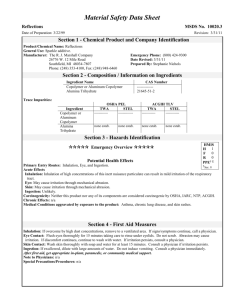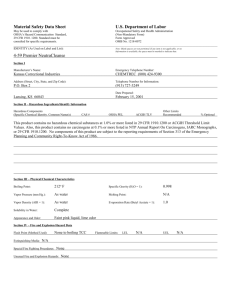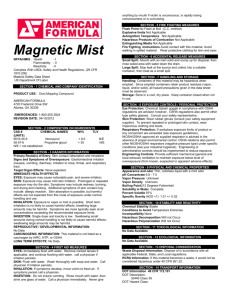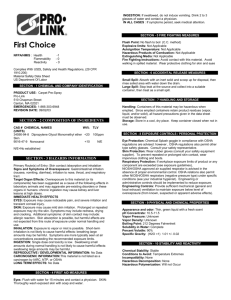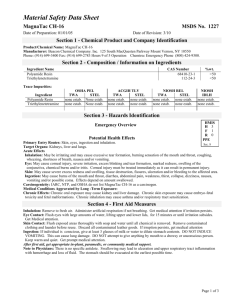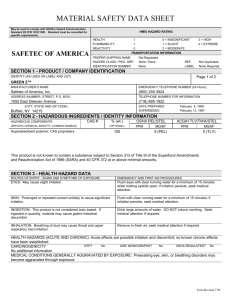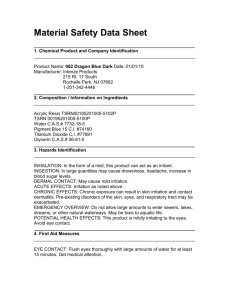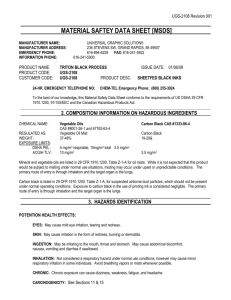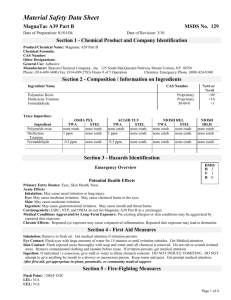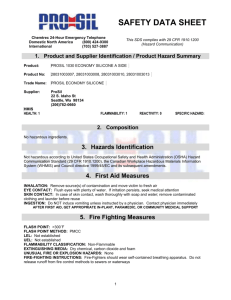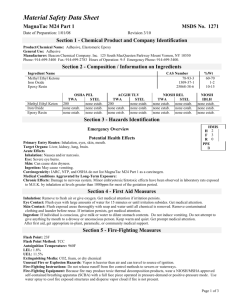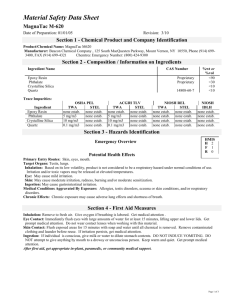MSDS Template, Word 5.0 for Mac
advertisement
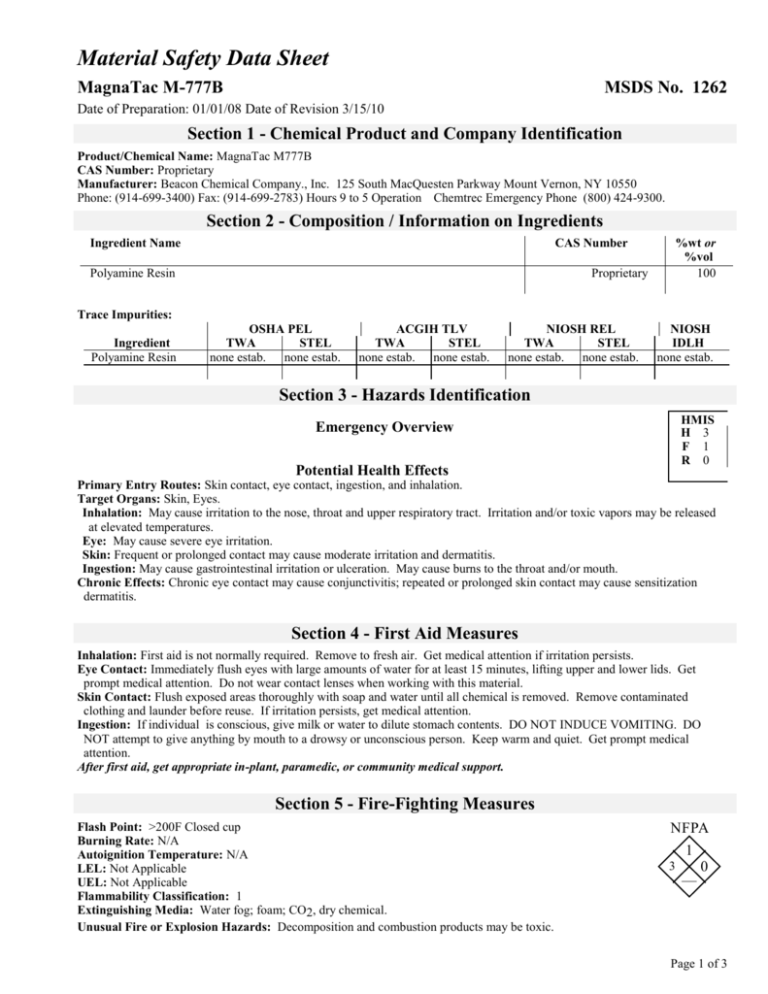
Material Safety Data Sheet MagnaTac M-777B MSDS No. 1262 Date of Preparation: 01/01/08 Date of Revision 3/15/10 Section 1 - Chemical Product and Company Identification Product/Chemical Name: MagnaTac M777B CAS Number: Proprietary Manufacturer: Beacon Chemical Company., Inc. 125 South MacQuesten Parkway Mount Vernon, NY 10550 Phone: (914-699-3400) Fax: (914-699-2783) Hours 9 to 5 Operation Chemtrec Emergency Phone (800) 424-9300. Section 2 - Composition / Information on Ingredients Ingredient Name CAS Number Polyamine Resin Proprietary %wt or %vol 100 Trace Impurities: Ingredient Polyamine Resin OSHA PEL TWA STEL none estab. none estab. ACGIH TLV TWA STEL none estab. none estab. NIOSH REL TWA STEL none estab. none estab. NIOSH IDLH none estab. Section 3 - Hazards Identification Emergency Overview Potential Health Effects HMIS H 3 F 1 R 0 Primary Entry Routes: Skin contact, eye contact, ingestion, and inhalation. Target Organs: Skin, Eyes. Inhalation: May cause irritation to the nose, throat and upper respiratory tract. Irritation and/or toxic vapors may be released at elevated temperatures. Eye: May cause severe eye irritation. Skin: Frequent or prolonged contact may cause moderate irritation and dermatitis. Ingestion: May cause gastrointestinal irritation or ulceration. May cause burns to the throat and/or mouth. Chronic Effects: Chronic eye contact may cause conjunctivitis; repeated or prolonged skin contact may cause sensitization dermatitis. Section 4 - First Aid Measures Inhalation: First aid is not normally required. Remove to fresh air. Get medical attention if irritation persists. Eye Contact: Immediately flush eyes with large amounts of water for at least 15 minutes, lifting upper and lower lids. Get prompt medical attention. Do not wear contact lenses when working with this material. Skin Contact: Flush exposed areas thoroughly with soap and water until all chemical is removed. Remove contaminated clothing and launder before reuse. If irritation persists, get medical attention. Ingestion: If individual is conscious, give milk or water to dilute stomach contents. DO NOT INDUCE VOMITING. DO NOT attempt to give anything by mouth to a drowsy or unconscious person. Keep warm and quiet. Get prompt medical attention. After first aid, get appropriate in-plant, paramedic, or community medical support. Section 5 - Fire-Fighting Measures Flash Point: >200F Closed cup Burning Rate: N/A Autoignition Temperature: N/A LEL: Not Applicable UEL: Not Applicable Flammability Classification: 1 Extinguishing Media: Water fog; foam; CO2, dry chemical. Unusual Fire or Explosion Hazards: Decomposition and combustion products may be toxic. NFPA 1 3 0 — Page 1 of 3 MSDS No. 1262 M-777B Hazardous Combustion Products: Combustible at high temperatures; Polymerization may take place at high temperatures. Fire-Fighting Instructions: Do not release runoff from fire control methods to sewers or waterways. Fire-Fighting Equipment: Because fire may produce toxic thermal decomposition products, wear a self-contained breathing apparatus (SCBA) with a full face piece operated in pressure-demand or positive-pressure mode. Section 6 - Accidental Release Measures Spill /Leak Procedures: Take up with sand or other absorbent material and place in container for later disposal. Containment: For large spills, dike far ahead of liquid spill for later disposal. Do not release into sewers or waterways. Regulatory Requirements: Follow applicable OSHA regulations (29 CFR 1910.120). Section 7 - Handling and Storage Storage Requirements: Store at room temperature. Avoid excessive heat. Regulatory Requirements: Store out of direct sunlight in a dry area. Maximum storage temperature is 100F. Section 8 - Exposure Controls / Personal Protection Ventilation: Provide general or local exhaust ventilation systems to maintain airborne concentrations below OSHA PELs (Sec. 2). Local exhaust ventilation is preferred because it prevents contaminant dispersion into the work area by controlling it at its source. Respiratory Protection: Seek professional advice prior to respirator selection and use. Follow OSHA respirator regulations (29 CFR 1910.134) and, if necessary, wear a MSHA/NIOSH-approved respirator. Select respirator based on its suitability to provide adequate worker protection for given working conditions, level of airborne contamination, and presence of sufficient oxygen. For emergency or non-routine operations (cleaning spills, reactor vessels, or storage tanks), wear an SCBA. Warning! Air-purifying respirators do not protect workers in oxygen-deficient atmospheres. If respirators are used, OSHA requires a written respiratory protection program that includes at least: medical certification, training, fit-testing, periodic environmental monitoring, maintenance, inspection, cleaning, and convenient, sanitary storage areas. Protective Clothing/Equipment: Wear chemically protective gloves, boots, aprons, and gauntlets to prevent prolonged or repeated skin contact. Wear protective eyeglasses or chemical safety goggles, per OSHA eye- and face-protection regulations (29 CFR 1910.133). Contact lenses are not eye protective devices. Appropriate eye protection must be worn instead of, or in conjunction with contact lenses. Safety Stations: Make emergency eyewash stations, safety/quick-drench showers, and washing facilities available in work area. Contaminated Equipment: Separate contaminated work clothes from street clothes. Launder before reuse. Remove this material from your shoes and clean personal protective equipment. Comments: Never eat, drink, or smoke in work areas. Practice good personal hygiene after using this material, especially before eating, drinking, smoking, using the toilet, or applying cosmetics. Section 9 - Physical and Chemical Properties Physical State: Liquid Appearance and Odor: Viscous amber liquid with amine odor Odor Threshold: N/A Vapor Pressure: <0.01 mm Hg at 20C Specific Gravity At 25C, (H20 = 1): 1.032 pH: CA. 11 Water Solubility: Very Slight Other Solubilities: N/A Boiling Point: >200C % Volatile: Nil Evaporation Rate: Not Noted Section 10 - Stability and Reactivity Stability: MagnaTac M777B is stable room temperature in closed containers under normal storage and handling conditions. Polymerization: Hazardous polymerization will not occur. Chemical Incompatibilities: Avoid strong oxidizing agents, acids, natural rubber. Hazardous Decomposition Products: Thermal oxidative decomposition of MagnaTac 661 Part B can produce oxides of carbon and nitrogen, aldehydes, smoke and soot. Section 11- Toxicological Information Toxicity Data:* Page 2 of 3 M-777B Eye Effects: Can cause severe irritation. Skin Effects: Prolonged or repeated contact may cause dermatitis or sensitization. Moderate skin irritant. MSDS No. 1262 Acute Oral Effects: Rat, oral, LD50: >8 g/kg Carcinogenicity: Non carcinogenic Mutagenicity: N/D Teratogenicity: N/D Section 12 - Ecological Information Ecotoxicity: N/A Environmental Fate Environmental Transport: N/A Environmental Degradation: N/A Soil Absorption/Mobility: N/A Section 13 - Disposal Considerations Disposal: Contact your supplier or a licensed contractor for detailed recommendations. Follow applicable Federal, state, and local regulations. Section 14 - Transport Information DOT Transportation Data (49 CFR 172.101): Shipping Name: Adhesive Shipping Symbols: Not regulated Hazard Class: None Packing Group: None Section 15 - Regulatory Information EPA Regulations: RCRA Hazardous Waste Number: Not listed (40 CFR 261.33) RCRA Hazardous Waste Classification (40 CFR 261.): Not classified CERCLA Hazardous Substance (40 CFR 302.4) unlisted specific per RCRA, Sec. 3001; CWA, Sec. 311 (b)(4); CWA, Sec. 307(a), CAA, Sec. 112 CERCLA Reportable Quantity (RQ), N/A SARA 311/312 Codes: H=1 SARA Toxic Chemical (40 CFR 372.65): Not listed SARA EHS (Extremely Hazardous Substance) (40 CFR 355): Not listed OSHA Regulations: Air Contaminant (29 CFR 1910.1000, Table Z-1, Z-1-A): Not listed OSHA Specifically Regulated Substance (29CFR 1910.) Not listed State Regulations: Section 16 - Other Information Prepared By: Peter Ryan Additional Hazard Rating Systems: California Proposition 65: This product is not known to contain any substance listed by the state of California as known to cause cancer or reproductive harm. Disclaimer: The information given and the recommendations made herein apply to our product(s) alone and not combined with other product(s). Such are based on our research and on data from other reliable sources and are believed to be accurate. No guarantee of accuracy is made. It is the purchaser's responsibility before using any product to verify this data under their own operating conditions and to determine whether the product is suitable for their purposes. Page 3 of 3
